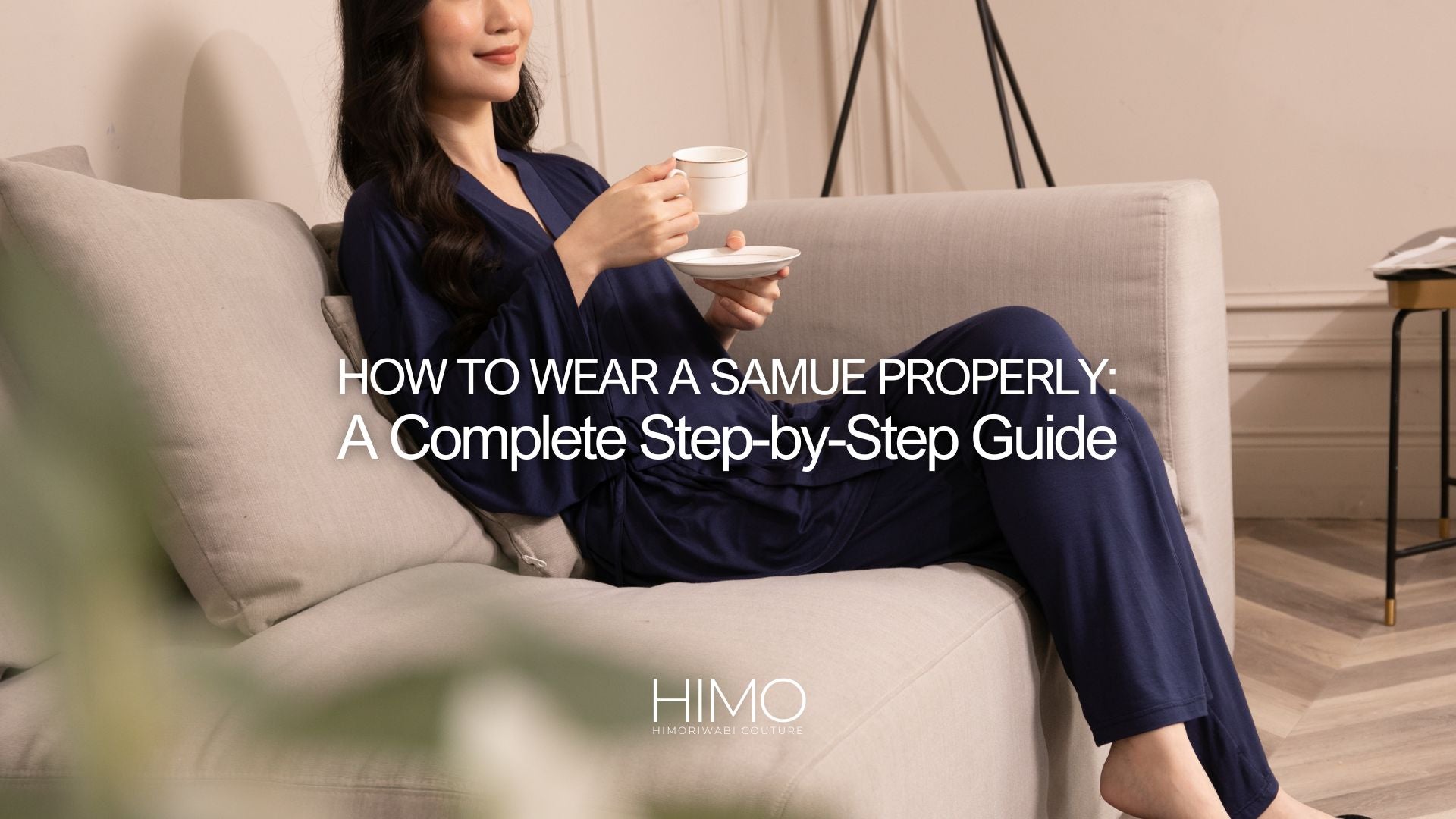By Master Takumi Kuroda (匠黒田)
There was a time when a Samue was not simply purchased, but earned. A young apprentice would receive his first samue from his master—not as just a garment, but as a symbol of dedication to his craft. The fabric, softened by years of labor, carried the quiet wisdom of those who had walked the path before him, reminding him of the discipline that each stitch and every seam represented.
But the world has changed. Factories now hum where family-run workshops once stood, and the hands that once wove these garments with patience and care have been replaced by machines that know nothing of true devotion. In such times, one must tread carefully when seeking an authentic samue, for not all that bears the name truly carries its spirit.
To those who wish to honor tradition, let me guide you.
Step 1: Find Your Perfect Samue Fit – Sizing Guide

A true samue must fit not just the body, but the rhythm of your life. Unlike modern uniforms, it should flow with your movements, enhancing ease rather than restricting it.
For those who work with precision, a close fit allows for controlled, steady movements. If you seek fluidity, a relaxed drape will let the fabric ripple with each breath. A generous cut offers freedom and comfort, embracing the body without restraint.
Do not fear the looseness of the samue. It is a garment that liberates, not binds, giving ease to the hands of the craftsman.
- Refer to our Samue Size Guide to find your perfect fit.
Step 2: How to Properly Wrap the Uwagi (上衣)

The uwagi is not simply a layer of cloth to be draped carelessly. It is the outer expression of the wearer’s state of being, carrying the weight of tradition in every fold. To wear it thoughtlessly is to forget its true purpose. But to wear it with quiet intention is to honor those who crafted it — the artisans who wove each thread, the monks who found peace in its simplicity, and the skilled hands that made it with precision.
When you don the uwagi, slip into it as you would a second skin, allowing the fabric to settle naturally over your shoulders. The left side should always overlap the right. This is more than tradition; it is a sign of life itself. The reverse is reserved for the deceased in burial robes. Let us not hasten fate.
Tie the inner and outer strings firmly, but leave enough room for the fabric to breathe. The samue is not meant to constrain but to accompany you in your movements and actions, offering comfort without restriction.
A properly worn uwagi is a sign of respect — not just for the garment, but for yourself.
Step 3: Adjust the Fit for Comfort
The samue is not a garment of constraint; it is one of liberation. It flows with the body, never against it, whether you are seated in quiet meditation, tending to a craft, or moving through the rhythm of daily life. It should rest upon the shoulders with ease, allowing the arms to move freely, as unrestricted as thought itself.
A well-crafted samue, made from soft, breathable fibers, does not impose; it breathes, adapts, and becomes an extension of the wearer. From the first light of morning to the hush of evening, it offers comfort that lingers and supports the wearer in both stillness and action.

Ensure the inner and outer ties are secure, but not too tight. The fabric should flow effortlessly, embracing you without restriction. The fit should feel natural — snug yet breathable — promoting a sense of tranquility and relaxation. During colder seasons, layering a light undershirt beneath your samue adds warmth while maintaining comfort and ease.
Step 4: Wearing the Zubon (ズボン) with Ease
A true garment should never burden the wearer. The zubon of a samue is crafted with the quiet understanding that it must follow not the whims of fashion, but the natural rhythm of the body. These trousers are meant to serve the wearer, to flow with movement — whether in the stillness of meditation, the steady labor at the workbench, or the quiet embrace of a morning breeze.
When putting on the trousers, step into them and pull them to a comfortable height. Adjust the elastic waistband so that it fits securely without causing tension. The fabric should drape naturally, neither dragging nor riding too high, allowing for ease of movement in every step.
Unlike the coarse work garments of old, Himoriwabi’s Samue is crafted with the modern artisan in mind. Our EverSoft Bamboo™ fabric breathes, stretches, and moves as the wearer moves, offering comfort not as a luxury, but as a quiet necessity. To wear it is to understand that freedom is not in excess, nor in constraint — it is in the effortless balance between form and function.
Step 5: Complete the Look

The samue is never worn in isolation. It is part of a greater whole, paired with elements that enhance both its function and the spirit of the wearer.
For comfort within the sanctuary of your home, the samue finds its perfect companion in the Himoriwabi Kumo. This garment, designed for effortless movement, mirrors the stillness and flow of the space around you, allowing the body to rest and breathe, unhindered by the demands of the outside world.
When preparing for meditation or Zen practice, the ritual of dressing extends to the spirit. Before donning your samue, cleanse both body and mind with the Himoriwabi Bath Ritual Kit. It is an essential step, a quiet preparation that allows the practitioner to approach the samue with reverence and presence, aligning the self with the peacefulness it embodies.
When stepping out into the world, the samue can be elevated further with the Himoriwabi Haori. This refined companion piece wraps the samue in quiet sophistication, turning it from a humble garment into a statement of thoughtfulness and grace. It speaks not with loud colors or patterns, but with the silent eloquence of those who move with purpose.
Worn with intention, the samue transforms. It is no longer just fabric. It becomes a part of your identity, a reflection of the quiet mastery you seek in each moment.
Step 6: Caring for Your Samue
The way you care for your samue is a quiet testament to your respect for the garment and what it represents. It is not just a piece of clothing — it is a companion that accompanies you through moments of stillness and action. To neglect it is to disregard the craftsmanship and spirit woven into every fiber.
When washing, choose cold water and a mild detergent, for the delicate fibers of the samue deserve gentle care. The warmth of the water should not overpower the softness of the fabric. Allow the samue to air dry, letting the natural integrity of the weave be preserved as it settles into its form once more.
If wrinkles must be removed, avoid high heat. Let steam, gentle and kind, restore the fabric’s smoothness. High temperatures can harm the delicate threads, just as impatience can erode the patience that comes with true craftsmanship.
Just as the samue serves you, so too must you serve it—with care and reverence. Understand that quality, like a skill honed over time, endures only when it is nurtured. By tending to your samue, you honor not only the garment but also the quiet mastery it represents.
Final Thoughts: The Spirit of the Samue
A samue is not merely worn. It is lived in.
Each fold, each stitch, and every softened edge that appears over time tells a story. It is the story of the wearer—a tale of quiet mastery, dedication, and the journey that unfolds with each movement. The samue absorbs not only the fabric of life but also the essence of its keeper.
Wear your samue with intention, as a reflection of your own purpose. Let your movements be guided by grace, and your actions grounded in purpose. When you do this, you will come to understand that the samue is not just a garment. It is a way of being, a companion that shapes the path you walk.
-
Shop Authentic Samue Now & Enjoy 20% OFF with Code: KAIZEN
Explore our best-selling Samue: https://himoriwabicouture.com/products/himoriwabi-eversoft-samue
Browse our full collection: https://himoriwabicouture.com/collections/samue



